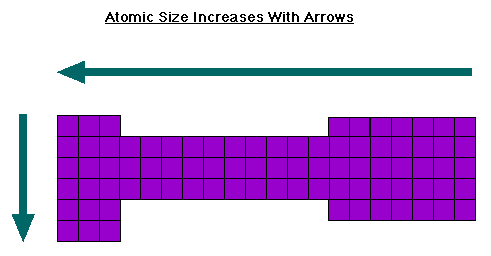


Note the odd transition from row 2 to 3!Įven this graph holds some mystery, but let’s begin with what jumps out:
Periodic table size trend series#
Please note that the row numbers below are referenced to the transition series only, not the periodic table as a whole.Ĭovalent radius as a function of group and row number. Covalent radius is a convenient metric for atomic size, particularly since we’re interested in the size of metals in OM complexes. The figure below shows the covalent radii of metals in groups 4-10. Trends in atomic size are probably the most straightforward of the transition series. Keep these ideas in mind to avoid spinning your wheels unnecessarily! Alright, let’s dive in… Atomic Size Using periodic trends to compare a Pd(II) complex and a Ru(III) complex is largely an exercise in futility, but comparing Pt(II) and Pd(II) complexes with similar ligand sets is reasonable. Secondly, periodic trends are significantly affected by the identity of ligands and the oxidation state of the metal center, so comparisons need to be appropriately controlled. For instance, general increases in a quantity may be punctuated by sudden decreases in such a case, we may say that the quantity increases generally, but definite conclusions are only possible when the metals under comparison are close to one another in the periodic table (and we need to be careful about unexpected jumps). Hartwig wisely advises that one should consider the transition series in blocks instead of as a whole when considering periodic trends. First of all, many of the trends across the transition series are not perfectly regular. In this post, we’ll hit on the major periodic trends of the transition metals and discuss a few examples for which these trends can be handy.īefore beginning, a couple of caveats are in order. Periodic trends essentially provide an exponential increase in predictive power. Of course, the same is true for organometallic complexes! With a firm grip on the periodic trends of the transition metals, we can begin to make comparisons between complexes we’re familiar with and those we’ve never seen before. Regular changes in electronegativity, atomic size, ionization energy, and other variables across the periodic table allow us to make systematic predictions about the behavior of similar compounds. Periodic trends play a huge role in organic chemistry.


 0 kommentar(er)
0 kommentar(er)
